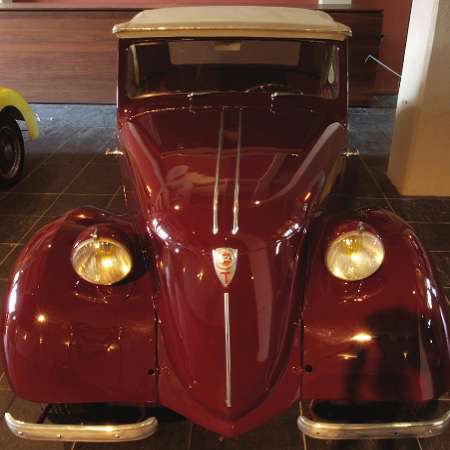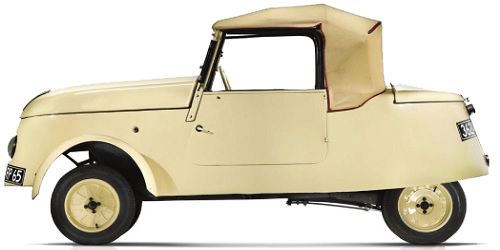Of electric cars in America there was virtually nothing. However, on the other side of the Atlantic, the British had discovered a new use for electric vehicles: household deliveries. Battery-powered vans and light trucks often had a greater payload capacity than their internal combustion-engined rivals and were used to ferry milk, eggs, bread and coal to homes in towns and cities. The outbreak of war in 1939 led to the development of larger milk vans because the number of deliveries per day had to be cut from two to one.
As the war dragged on, both sides needed to preserve every precious gallon of gasoline for the Armed Forces. Germany developed electric vehicles as a cheap and efficient way of keeping its transport and delivery infrastructure running. It had more than 27,000 in service. The British Government responded with a marketing campaign similar to the one run by the Electric Vehicle Association of America three decades earlier. It stressed the advantages of an electric vehicle – simplicity, less maintenance and lower running costs (electricity was a quarter the price of petrol during the war years).
The world famous Harrods department store, in London’s wealthy Knightsbridge district, had operated electric vehicles since 1919 when it invested in an American-made Walker electric van to speed up local deliveries. In 1936, the store splashed out on a fleet of sixty coach-built 1-ton vans. Their 60-mile (96km) range and 19mph (30km/h) top speed made them the perfect way to deliver bulky items to wealthy customers, and their silent running was entirely in keeping with Harrods’ upper-class image.
The batteries, which gave a total of 60V, were stored under the floor either side of the chassis in two boxes, and the motor was rated at 3.5bhp. Indeed, they were so successful that they remained in service for 30 years and one even features in the Beatles film Help!. By the time they were taken out of service some had covered as many as 350,000 miles. Harrods recently restored one of the vans to pristine condition and presented it to the Science Museum, London.

Although the Co-op did its bit for the war effort by running large electric fleets across the country, electric vehicles failed to decisively break out of the delivery van niche they had made their own since the late 1920s. The country was locked in a life-or-death struggle, which was hardly conducive to the development of a new electric car industry with or without government support.
A shortage of petrol during World War II caused a brief period of interest in electric vehicles. More than a dozen companies built electrics during the war years, mostly in France, but also in Italy, where the famous Maserati factory gave up on race cars to build electric vehicles for the war effort.

One of the most striking French efforts was the CGE-Tudor. A joint project between the Tudor Accumulators Company and the General Company of Electricity, it was designed by the famous French engineer Jean-Albert Gregoire, who used an aluminium frame clothed by bolted-on sheet-metal pressings. Gregoire was familiar with the lightweight advantages of aluminium, having already used Alpax, an aluminium alloy, in the design of the Amilcar Compound B38. Indeed, when Gregoire started work on an electric vehicle in 1938 he toyed with the idea of creating a battery-powered version of the Amilcar Compound but eventually opted for a purpose-built design. However, the GCE-Tudor shared a number of components in common with the Compound.
In September 1942, Gregoire managed to drive from Paris to Tours – a distance of 158 miles (254 km) – on a single charge at an average speed of 26.2 mph (42.32 km/h), which was no mean feat in occupied France. Presumably this was a special, however, as the standard range was 56 miles (90km). The forty-eight cells, split between the boot and under the long bonnet, weighed over 1,000 lb (460 kg). The motor was placed in the centre of the car for benign handling and drove the rear wheels.
The CGE-Tudor was strictly for two people, who sheltered beneath a canvas top. This allowed for a small luggage storage area behind the seats. The dashboard, fashioned from sheet metal and painted the same colour as the bodywork, featured a forward/reverse switch, lighting switch, rear-view mirror, an ammeter to keep an eye on charge reserves, a horn and turn signals. Rather confusingly, the car had three conventional-looking pedals: an accelerator, a brake and, in the place of a clutch, a decelerator. The CGE-Tudor was a revelation at the time but its price – the equivalent of three Citroëns – put it beyond the reach of any but the wealthiest.
Nevertheless, production ran at the modest rate of two vehicles per week – although none were ever exported beyond France. As money was short, the company was sometimes prepared to barter for a car. One was allegedly handed to the managing director of a biscuit factory in return for his weight in biscuits. A van appeared in 1944 and plans were laid down for a four-door saloon. After the war a pretty-looking coupé was shown at the Paris Salon in October 1946, but never went into production.
In 1942, one of France’s biggest pre-war car manufacturers – Peugeot – wheeled out an electric microcar. The Nazis had taken over French factories to make arms and they imposed harsh petrol restrictions to preserve fuel supplies for the Wehrmacht. The little Voiture Legere de Ville (Light City Car) used four 12V batteries placed beneath the bonnet. It had three wheels – two at the front and one at the back – and Peugeot claimed it had a top speed of 22mph (36km/h) and a range of 50 miles (80 km). The VLV weighed 771 lb (350 kg) of which 352 lb (160 kg) were the batteries. The VLV was used for distributing the post and dispensing medical supplies. It was very popular and Peugeot made 377 examples before the Germans banned all electric car production.

Peugeot would remain an enthusiastic supporter of electric cars into the 1980s and 1990s. In 2011, it was the first major manufacturer to bring a diesel-electric hybrid to the mass market but, to date, the 3008 Hybrid4 has failed to set the market alight, proving barely more frugal than a petrol–electric and considerably inferior to a much cheaper Peugeot turbo-diesel.
The Second World War also forced two of France’s most prolific electric car makers to join forces. Charles Milde had been building EVs since 1898, about the same time as electrical engineer Louis Krieger. Following the German occupation, the two men jointly designed an electric motor that was fitted to a 1939 6/7 CV La Licorne. They also converted a van. Around 150 examples of the Milde–Krieger were built between March 1941 and July 1942, before the German authorities called a premature halt.
This enforced interest in electric cars came to an end after the war when oil supplies returned to normal. Most of the Milde-Kriegers that survived suffered the ignominy of conversion to a petrol engine.